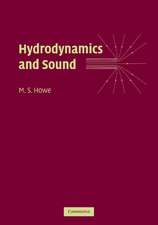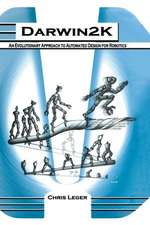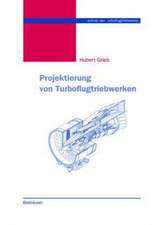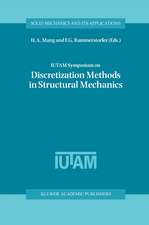High Pressure Rheology for Quantitative Elastohydrodynamics
Autor Scott S. Bairen Limba Engleză Hardback – 5 mar 2007
* Presents the property relations required for a quantitative calculation of the tribological behaviour of lubricated concentrated contacts.* Details of high-pressure experimental techniques.* Complete description of the pressure and temperature dependence of viscosity for high pressures.* Some little-known limitations on EHL modelling.
| Toate formatele și edițiile | Preț | Express |
|---|---|---|
| Paperback (1) | 1242.15 lei 36-50 zile | |
| ELSEVIER SCIENCE – 19 apr 2019 | 1242.15 lei 36-50 zile | |
| Hardback (1) | 1196.49 lei 43-57 zile | |
| ELSEVIER SCIENCE – 5 mar 2007 | 1196.49 lei 43-57 zile |
Preț: 1196.49 lei
Preț vechi: 1639.02 lei
-27% Nou
Puncte Express: 1795
Preț estimativ în valută:
229.02€ • 248.85$ • 192.50£
229.02€ • 248.85$ • 192.50£
Carte tipărită la comandă
Livrare economică 21 aprilie-05 mai
Preluare comenzi: 021 569.72.76
Specificații
ISBN-13: 9780444522436
ISBN-10: 0444522433
Pagini: 260
Dimensiuni: 165 x 240 x 27 mm
Greutate: 0.59 kg
Editura: ELSEVIER SCIENCE
ISBN-10: 0444522433
Pagini: 260
Dimensiuni: 165 x 240 x 27 mm
Greutate: 0.59 kg
Editura: ELSEVIER SCIENCE
Public țintă
For engineers and researchers concerned with high-pressure lubricationCuprins
Chapter 1. An Introduction to Elastohydrodynamic Lubrication1.1 Lubrication1.2 Concentrated Contact Lubrication1.3 Full Elastohydrodynamic Lubrication1.4 Experimental Elastohydrodynamics1.5 ConclusionChapter 2. An Introduction to the Rheology of Polymeric Liquids2.1 Background2.2 The Newtonian Model2.3 Material Functions for Polymeric Liquids2.4 Rheological Models2.5 Time-Temperature-Pressure Superposition2.6 Liquid FailureChapter 3. General High-Pressure Experimental Techniques3.1 Background3.2 Pressure Containment3.3 Closures3.4 Feed-throughs3.5 Pressure Generation and Measurement3.6 Hydrostatic Media and Volume CompensationChapter 4. Compressibility and the Equation of State4.1 Background4.2 PVT Measurement Techniques and Results4.3 Empirical Equations of StateChapter 5. The Pressure and Temperature Dependence of the Low-Shear Viscosity5.1 Background5.2 High-Pressure Viscometers5.3 General Pressure-Viscosity Response and Results for Pure Organic Liquids and LubricantsChapter 6. Models for the Temperature and Pressure Dependence of the Low-Shear Viscosity6.1 Introduction6.2 Models for the Temperature-Viscosity Response6.3 Pressure Fragility and Empirical Models for High Pressure Behavior6.4 The Pressure-Viscosity Coefficient and Empirical Models for Low Pressure Behavior6.5 Empirical Models for Large Pressure Intervals6.6 Models Based on Free Volume Theory6.7 Generalized Temperature-Pressure-Viscosity Models6.8 Multi Component SystemsChapter 7. Measurement Techniques for the Shear Dependence of Viscosity at Elevated Pressure7.1 Introduction7.2 Phenomena Producing Behavior Similar to Shear-Thinning7.3 Rheometers for High PressureChapter 8. The Shear Dependence of Viscosity at Elevated Pressure8.1 Introduction8.2 Normal Stress Differences at Elevated Pressures8.3 The Origin of Non-Newtonian Behavior in Low-Molecular-Weight Liquids at Elevated Pressures8.4 Time-Temperature-Pressure Superposition8.5 The Competition between Thermal Softening and Shear-Thinning8.6 Multi Component Systems8.7 The Power-Law Exponent and the Second Newtonian ViscosityChapter 9. Glass Transition and Related Transitions in Liquids under Pressure 9.1 Measurements of Glass Transition at Elevated Pressure9.2 Measurements of Dielectric Transition at Elevated Pressure9.3 The Transitions as Isoviscous States 9.4 The Pressure Variation of Viscosity across the TransitionChapter 10. Shear Localization, Slip and the Limiting Stress10.1 Introduction10.2 Measurements of Rate Independent Shear Stress10.3 Flow Visualization of Shear Bands10.4 Mohr-Coulomb Failure Criterion 10.5 Change of Character of the Piezoviscous Navier-Stokes Equations10.6 Thermal Localization, Adiabatic Shear Bands10.7 Interfacial SlipChapter 11. The Reynolds Equation11.1 Background11.2 Reynolds Equations for Generalized Newtonian FluidsChapter 12. Applications to Elastohydrodynamics12.1 Introduction12.2 Film Thickness for Shear Thinning Liquids12.3 The Calculation of Traction from Material Properties

























